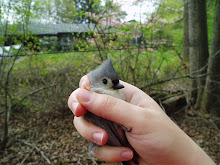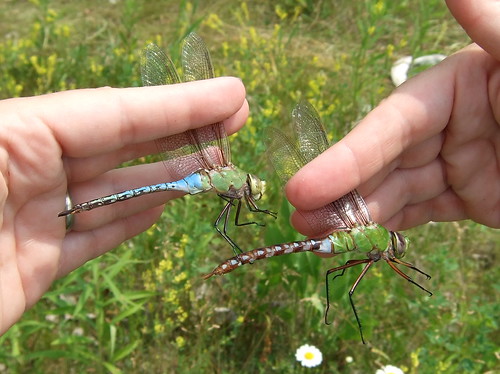I post a lot about what's going on in the world of science, but I haven't posted much about what I'm doing.
Today, that changes.
Ladies and gents, this is Anax junius, the green darner dragonfly:
Take a good look, because you'll be hearing a lot about these guys in the future.
Today was a testing day for Mike and myself. (Mike is my advisor.) We received some very small transmitters a few weeks ago, but because of various things (his trip to South Africa, my shuffling between NJ and LI, logistics, etc.) the plan finally came together only this week.
(Please bear with me. I forgot my camera, I will try to describe things as well as I can, and I will hopefully have some more pictures tomorrow.)
After borrowing a van from Princeton, which may or may not prove handy depending on how well we can use our radio antenna, we headed to a pond and spotted a few Anax. Mike being in possession of the one pair of waders, he went on in while I stayed on shore in case any made an escape attempt in my direction. We were very lucky, and Mike bagged a male (like the picture above) within a few minutes. Back on shore, we sat down in the shade (don't want the little guy to overheat) and proceeded to apply a radio transmitter with a combination of eyelash adhesive and crazy glue. Once it was on, he sat on Mike's finger, shivered his flight muscles for a few minutes to warm back up, and took off.
We were able to follow him for a bit into some trees (apparently, green darners that have been man-handled will retreat to trees away from the pond) and then lost the signal. Driving around, we were able to find his blip again, only to lose it a few minutes later. We are concerned that the soldering was not as firm as we'd like and the transmitter may only be transmitting intermittently (that's a mouthful!).
Our plan for tomorrow is to 1) try to find our guy again in the same area. If we are successful... well, actually I don't know. I think we'll just try to keep an eye on him as long as we can. 2) If we can't find him, we'll first do a practice run with just a transmitter to test the range of a properly-functioning beacon. After that... probably try to bag another one and follow it around for a while.
What's the point of all this? Well, our project is on migration in Anax. So, we're trying to figure out whether it's even feasible to tag one, relocate it, and follow it for several days over land. It has been done before, but we're both new-ish to the technique. And it's not easy.
I'll post more in the next few days about the exciting world of insect endocrinology and how hormones may influence migratory behavior -- an under-explored area which might become part or all of my project if it proves too difficult to consistently follow tagged individuals. Also, pictures next time.
PS: In case you were thinking that we were attaching big, heavy transmitters to dainty damselflies, rest assured, we are not. Green darners are anything but dainty. Go out to a pond, take a look at all the dragonflies you see, and look for the biggest thing flying around. That's probably an Anax species. A picture for size comparison:
I didn't take this picture and those aren't my hands, but this will give you some idea of just how big these guys are. Totally harmless, of course, but definitely massive!
Tuesday, August 12, 2008
Better Know an Insect: Anax junius, part I
Labels:
animal behavior,
animals,
better know an insect,
ecology,
habitat,
science
Subscribe to:
Post Comments (Atom)






No comments:
Post a Comment